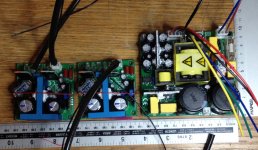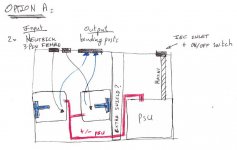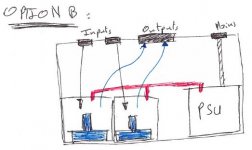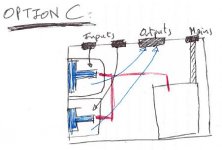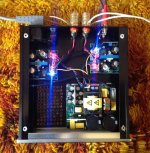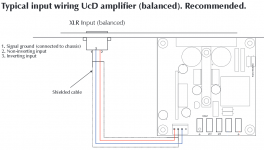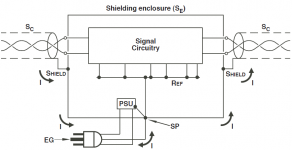Hi all,
I've bough a pair of UcD180HG amps from Hypex and the matched SMPS400A180 psu, all prebuilt. I also bought the optional cables for practicality. This is what it all looks like:
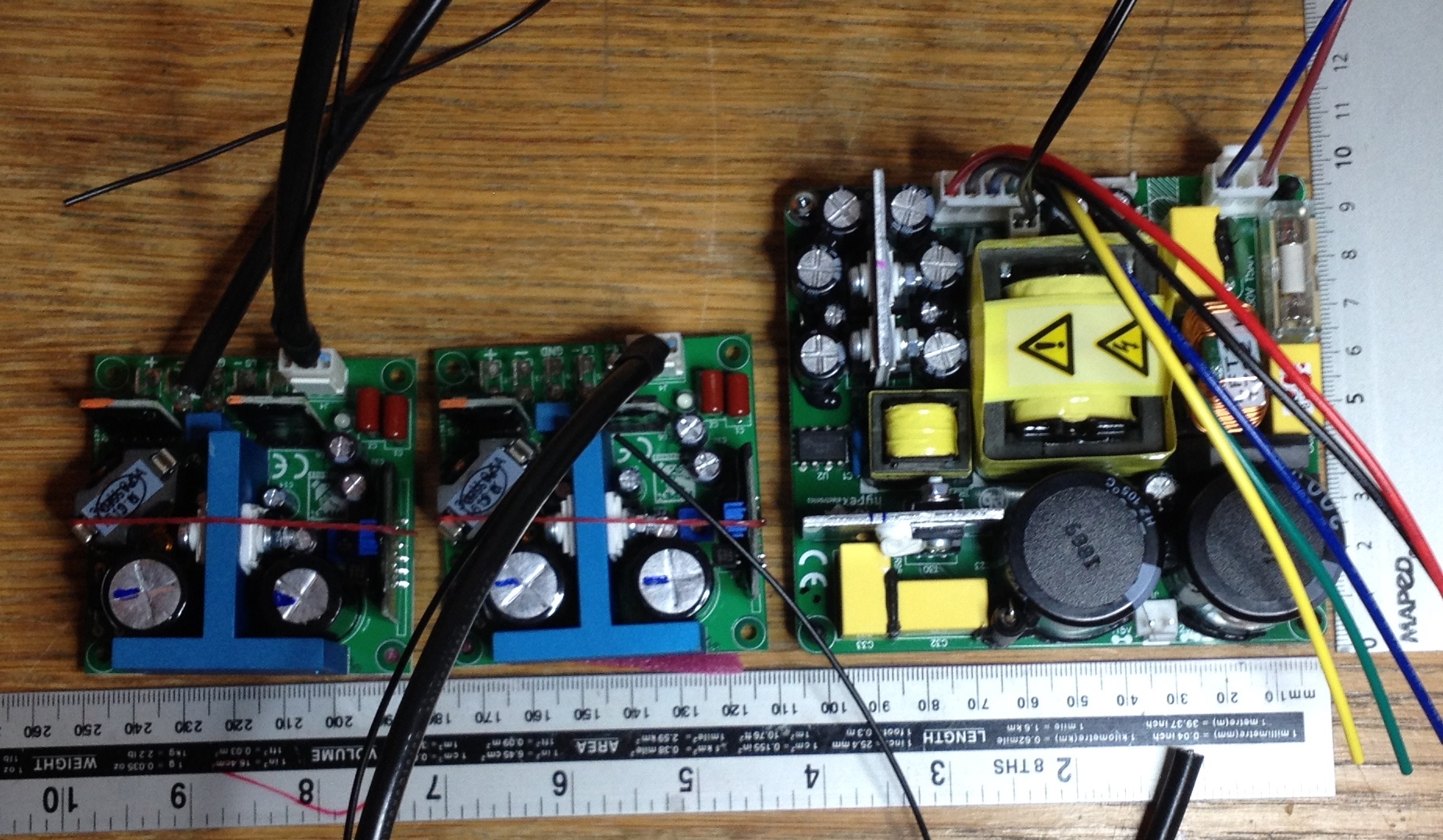
I intend to use this forum thread to record my progress & thoughts along the way.
I will also be looking for guidance throughout the build process. All input is welcome, but please try and stick to substantiated advice: I'm less keen on biased opinion than on measured facts. Having said that, I'm happy to go NASA-grade overkill where there is a concrete and rational benefit, albeit small.
Thanks in advance to anybody who will kindly help and advise at any point, may this be a great learning journey!
I've bough a pair of UcD180HG amps from Hypex and the matched SMPS400A180 psu, all prebuilt. I also bought the optional cables for practicality. This is what it all looks like:
I intend to use this forum thread to record my progress & thoughts along the way.
I will also be looking for guidance throughout the build process. All input is welcome, but please try and stick to substantiated advice: I'm less keen on biased opinion than on measured facts. Having said that, I'm happy to go NASA-grade overkill where there is a concrete and rational benefit, albeit small.
Thanks in advance to anybody who will kindly help and advise at any point, may this be a great learning journey!
Attachments
To kick things off: I need a chassis. I am looking for an enclosure that
First set of real questions:
1. I have used aluminum enclosures in previous projects but now I have discovered mu-metal and I'm not sure if they really make a difference?
2. I believe these amps aren't very sensitive to RFI but I wonder if it would be worth adding an extra bar of shielding metal inside the box (see Option A drawing), between amps and psu, to block radiations from the latter?
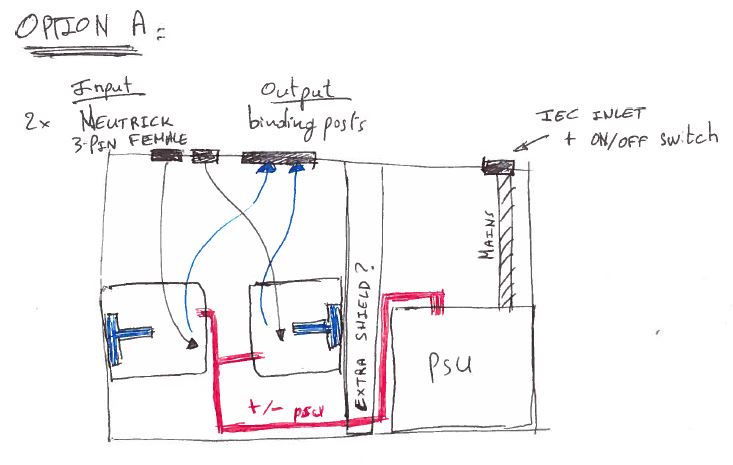
3. Though the amps are class D (= low heat), I would prefer to bolt the amps heatsinks (= blue T-shaped parts) to the chassis for optimal heat dissipation, as recommended by the manufacturer. If I go without extra shield mentioned at point 2, I am not yet sure whether I should bolt them to the front plate, or rather to a side plate. Any thoughts?
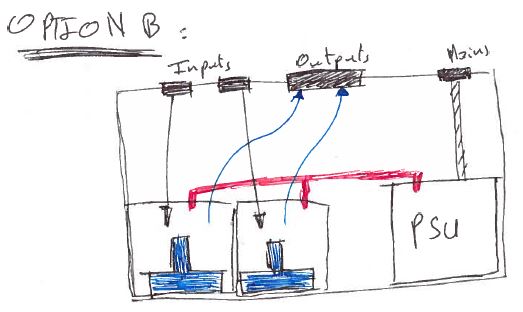
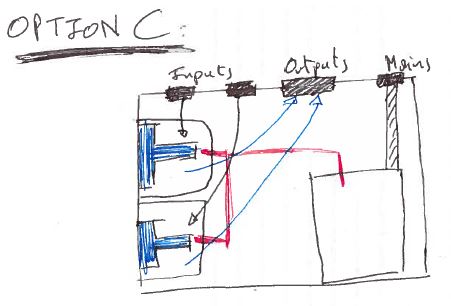
- looks good enough for my living room
- offers optimal interferance shielding for the broadest frequency range possible, most importantly 20-20K Hz and
- has the smallest form factor possible.
First set of real questions:
1. I have used aluminum enclosures in previous projects but now I have discovered mu-metal and I'm not sure if they really make a difference?
2. I believe these amps aren't very sensitive to RFI but I wonder if it would be worth adding an extra bar of shielding metal inside the box (see Option A drawing), between amps and psu, to block radiations from the latter?
3. Though the amps are class D (= low heat), I would prefer to bolt the amps heatsinks (= blue T-shaped parts) to the chassis for optimal heat dissipation, as recommended by the manufacturer. If I go without extra shield mentioned at point 2, I am not yet sure whether I should bolt them to the front plate, or rather to a side plate. Any thoughts?
Attachments
pierrepierrepierre,
All of your layouts will work.
My understanding is that it is a good practice to keep the input and speaker post connector wires short. Your first image shows that you plan to use balanced inputs, so in that case input connector wire length will not be a cause of concern. Foxx510 has a nice compact layout and if you notice he's twisted all the connector cables well.
From what I have read about the Hypex SMPS and modules, have not come across advice/recommendations on extra shielding.
All of your layouts will work.
My understanding is that it is a good practice to keep the input and speaker post connector wires short. Your first image shows that you plan to use balanced inputs, so in that case input connector wire length will not be a cause of concern. Foxx510 has a nice compact layout and if you notice he's twisted all the connector cables well.
From what I have read about the Hypex SMPS and modules, have not come across advice/recommendations on extra shielding.
Nice build Foxx510, very neat!
Where do you guys buy your enclosures from?
With regards to shielding, I've glanced at Cindy Cheung's comparative study (2009), where she looks at the effectiveness for three types of shielding tape: superalloy, aluminum, and mumetal. She concludes that:
Any thoughts on Mu-metals/Superalloys?
Where do you guys buy your enclosures from?
With regards to shielding, I've glanced at Cindy Cheung's comparative study (2009), where she looks at the effectiveness for three types of shielding tape: superalloy, aluminum, and mumetal. She concludes that:
[For all three shielding tapes in all three fields], aluminum was evidently the least effective while superalloy was the most effective. [...]
The minimum frequency for superalloy to be sufficient in the magnetic field proved to be 5 KHz. Conversely, superalloy was efficient in the electric field for the entirefrequency spectrum, and from 50 Hz in the plane wave. Mumetal demonstrated results similar to superalloy. The minimum frequency for effective shielding proved to be 1 MHz in the magnetic field, the entire frequency spectrum in the electric field, and 500 Hz in plane wave.
The minimum frequency for superalloy to be sufficient in the magnetic field proved to be 5 KHz. Conversely, superalloy was efficient in the electric field for the entirefrequency spectrum, and from 50 Hz in the plane wave. Mumetal demonstrated results similar to superalloy. The minimum frequency for effective shielding proved to be 1 MHz in the magnetic field, the entire frequency spectrum in the electric field, and 500 Hz in plane wave.
Any thoughts on Mu-metals/Superalloys?
Modushop by Hi-Fi 2000 | Contenitori per Elettronica | Electronic Enclosures | Hi Fi ChassisWhere do you guys buy your enclosures from?
Don't bother with this anymore. There are several other way more important areas of improvement. Search the forum.Any thoughts on Mu-metals/Superalloys?
Hypex modules, if implemented correctly, are DEAD QUIET even mounted on the peace of MDF. My experience.
Use the full aluminum enclosure and make the wiring strictly according to the suggestion of the Hypex.
Read the white papers on their site.
I would also recommend you to think on purchasing the onother one SMPS for dual mono construction...
Last edited:
Thanks for the enclosure manufacturer website, I will go for aluminum as mu metal etc. seem way harder to come by, waste of time indeed.
FWIW, Hypex also suggested to use 2 PSU, but I felt like their advice was biased according to their own commercial interests. I pressed on and asked them to substantiate the claim and quantify the improvement, several times, but they didn't. I went on and asked B. Putzeys (the original designer and inventor of NCore). His reply was:
I would also recommend you to think on purchasing the onother one SMPS for dual mono construction...
FWIW, Hypex also suggested to use 2 PSU, but I felt like their advice was biased according to their own commercial interests. I pressed on and asked them to substantiate the claim and quantify the improvement, several times, but they didn't. I went on and asked B. Putzeys (the original designer and inventor of NCore). His reply was:
I find the difference between 1 or 2 supplies for 2 channels quite small. [...] Personally I feel the overall impact quite small so I've always tended to use one supply for 2 channel test builds. So technically they're right, a separate supply would improve things - just not very much. The PSRR of the UcD modules is more than good enough in practice.
I have scanned their papers in the past and found them to be of limited practical value. Do you reckon I should take a fresh look at any one in particular?Read the white papers on their site.
My enclosure came from here Breeze Audio - Small Orders Online Store, Hot Selling and more on Aliexpress.com | Alibaba Group
Hi, this is mine. Use one SMPS for all 8 ch...
An externally hosted image should be here but it was not working when we last tested it.
I bought a Breeze 2207 all aluminum chassis because:
- it has flat side panels to which the amp heat-sinks can be tapped.
- it is the smallest I could find with enough internal space to comply with safety regulations (see SMPS400A100 datasheet section 9):
[The SMPS400A100] is a Safety Class 2 device. When mounting the module in an enclosure, a minimum safety distance of 6mm from the SMPS to all possible conducting parts must be ensured to keep compliance with Safety Class 2. This includes parts on the top, the bottom and all sides of the board.
Shield [...] systems with steel. [...] Aluminum [...] should be avoided — aluminum conduit provides only electric field shielding
Last edited:
His reply was:I find the difference between 1 or 2 supplies for 2 channels quite small. [...] Personally I feel the overall impact quite small so I've always tended to use one supply for 2 channel test builds. So technically they're right, a separate supply would improve things - just not very much. The PSRR of the UcD modules is more than good enough in practice.
Bruno was honest and humble in telling you that.
My finding is that if you want to squeeze the maximum from these modules then dual mono is the way to go.
You should gain a bit more of dynamics, more precision, focus, soundstage and a better controll overall. This is my experience but YMMV.
I have scanned their papers in the past and found them to be of limited practical value. Do you reckon I should take a fresh look at any one in particular?
Hypex.nl
Read the FAQ section and all applications notes documents.
This is must if you really want to obtain the maximum possible result.
However Jim Brown agrees that aluminum is inferior to a ferrous metal (here iron) for audio shielding...
If so than all high end amplifiers should be made with ferrous metal enclosures but, actually, they are not...
This is not a high end project although you can expect a really excellent result for that amount of money.
When you settle on all this then you could start considering some already proven tweaks.
My finding is that if you want to squeeze the maximum from these modules then dual mono is the way to go.
You should gain a bit more of dynamics, more precision, focus, soundstage and a better controll overall. This is my experience but YMMV.
Did anybody perform & record measurements at all? I'm always wary of McGurkk-type psychoacoustic phenomenons, whereby the listener's brain will really perceive a different sound if they want it hard enough (as could be the case if you had spent, say, an extra $100 on a second PSU).
than all high end amplifiers should be made with ferrous metal enclosures but, actually, they are not...
Indeed Putzey's application note on UcD and EMI demonstrates that well-designed switching circuits emit only very low levels of parasitic RF signals, which is reassuring. Thanks for pushing me to look at Hypex application notes better, BTW
I'm still concerned with the parasitic sensitivity of the system though; e.g. I may for have a computer or video screen radiating crap very near the amplifier.
start considering some already proven tweaks
The boards are very precisely designed systems that balance a wide range of potentially problematic parameters. So I'm inclined to trust reputable designers, and not keen on modding these boards themselves for fear of unsettling something to upgrade another. I am however trying to integrate the 3 boards together as well as possible. What do you have in mind?
Now that I have a chassis, I need to work out wiring. I have Neutrik XLR connectors for balanced L & R inputs. At the moment I am confused by a contradiction between the AES-48 standard on interconnections (top) and Hypex's Amplifier signal input wiring Application Note (bottom):
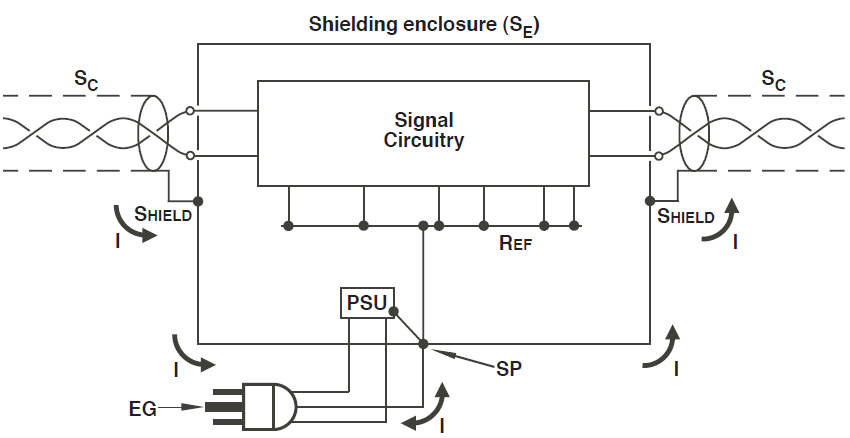
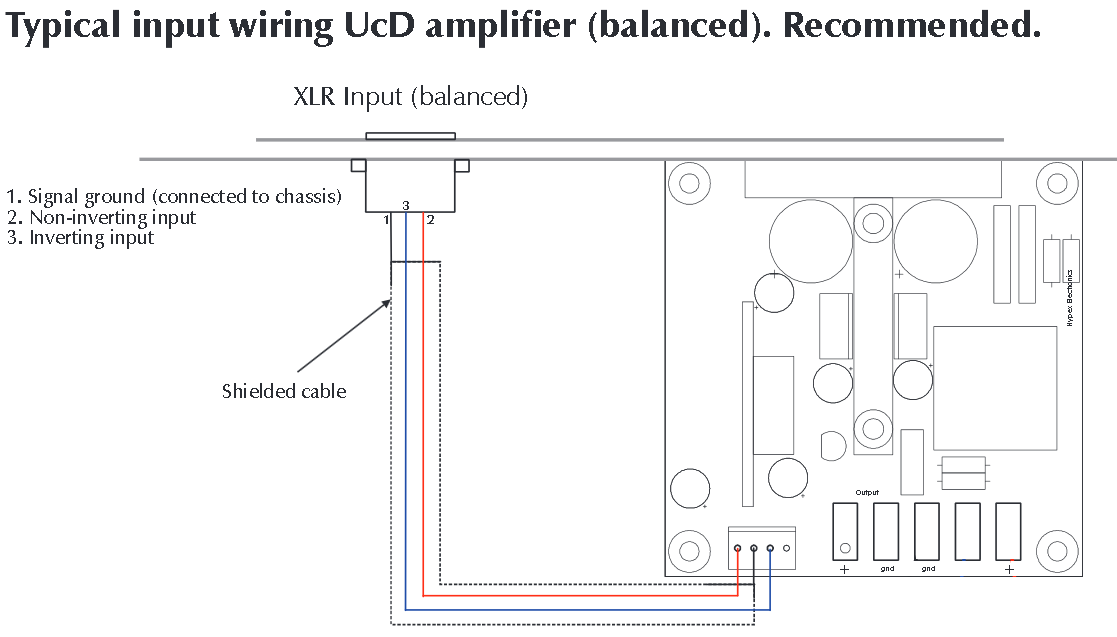
I'm not 100% sure on which is best yet, though I believe Hypex's recommendation is a likely source of "pin 1" problems (see Jim Brown's Pin 1 revisited article) ?
- The AES recommends to connect mains earth, PSU ground & audio ground to the chassis together at a common star point, distinct from the audio connector;
- Hypex recommend to connect the amplifier's signal ground to the chassis at the input XLR connector.
I'm not 100% sure on which is best yet, though I believe Hypex's recommendation is a likely source of "pin 1" problems (see Jim Brown's Pin 1 revisited article) ?
Attachments
I built a power amp with two UcD700 and a SMPS1200A700 some weeks ago. I connected the pin 1 (which is joined to the cable shield) with the chassis, which is in turn connected to mains ground and all is ok with zero peoblems.Now that I have a chassis, I need to work out wiring. I have Neutrik XLR connectors for balanced L & R inputs. At the moment I am confused by a contradiction between the AES-48 standard on interconnections (top) and Hypex's Amplifier signal input wiring Application Note (bottom):


- The AES recommends to connect mains earth, PSU ground & audio ground to the chassis together at a common star point, distinct from the audio connector;
- Hypex recommend to connect the amplifier's signal ground to the chassis at the input XLR connector.
I'm not 100% sure on which is best yet, though I believe Hypex's recommendation is a likely source of "pin 1" problems (see Jim Brown's Pin 1 revisited article) ?
Gaetano.
I connected the pin 1 (which is joined to the cable shield) with the chassis, which is in turn connected to mains ground and all is ok.
Thanks Gaetano. Could you clarify a couple of point on your wiring scheme?
- Where did you connect pin 1 to the chassis? Immediately at the connector or via a wire?
- Where did you connect your chassis to the mains ground? At the same chassis point as (a) the input signal connector? (b) the PSU ground? (c) the audio (amplifier board) ground? (d) any combination of a/b/c?
For info, I also wrote and asked Hypex directly about their wiring scheme vs. AES48. They advised to go and read their Legacy pin 1 problem application note, which I did. It is very informative, and strongly advocates the implementation of AES48... This is in contradiction with their recommended wiring scheme (as of schema 1 & schema 2) and confused me further.
I replied and asked if they could supply a UcD + SMPS wiring schematic that follows good practice by implementing AES48, as prescribed in their own application note.
Hi Pierre,
I carefully followed the instructions of the wiring connection schematics supplied by Hypex. So, via a thin wire, I connected the input pin 1 to the chassis, at the same point of mains ground, which I always connected to the chassis with a yellow-green wire. The psu, as told me by Hypex, doesn’t need to be grounded to the chassis because their psu (SMPS1200A700) is “class 2 safety” product (they told me that the electrical contact between the chassis and the metal plate underneath the psu is enough) and so also the amp modules. In this way, I got a dead-silent power amp, reallly, I was astonished of how silent was this amp the first time I turned it on. Even with the volume control of my dac Teac UD301, which I use as a preamp, turned to max, with my ears on the tweeter I didn’t hear anything. So I would advice you to try to go this way first, then if you don’t obtain a satisfying result, try otherwise. But I think you will raech you target, cause I think Hypex products are very reliable. Let me know!
Gaetano.
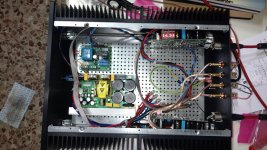
I carefully followed the instructions of the wiring connection schematics supplied by Hypex. So, via a thin wire, I connected the input pin 1 to the chassis, at the same point of mains ground, which I always connected to the chassis with a yellow-green wire. The psu, as told me by Hypex, doesn’t need to be grounded to the chassis because their psu (SMPS1200A700) is “class 2 safety” product (they told me that the electrical contact between the chassis and the metal plate underneath the psu is enough) and so also the amp modules. In this way, I got a dead-silent power amp, reallly, I was astonished of how silent was this amp the first time I turned it on. Even with the volume control of my dac Teac UD301, which I use as a preamp, turned to max, with my ears on the tweeter I didn’t hear anything. So I would advice you to try to go this way first, then if you don’t obtain a satisfying result, try otherwise. But I think you will raech you target, cause I think Hypex products are very reliable. Let me know!
Gaetano.

- Status
- This old topic is closed. If you want to reopen this topic, contact a moderator using the "Report Post" button.
- Home
- Amplifiers
- Class D
- Dual Hypex UcD180 amplifier build
